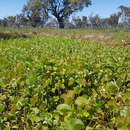mk
имиња во трошки


Marsilea drummondii is a species of fern known by the common name nardoo.[2] It is native to Australia, where it is widespread and common, particularly in inland regions. It is a rhizomatous perennial aquatic fern that roots in mud substrates and produces herbage that floats on the surface of quiet water bodies. It occurs in water up to one metre deep.[3] It occurs in abundance after floods.[4] It can form mats on the water's surface and cover the ground in carpets as floodwaters recede. It is variable in appearance and occurs in many types of wetland habitat. In general the frond is made up of two pairs of leaflets and is borne erect when not floating.
The plant produces sporocarps which can remain viable for 50 years and only release spores after being thoroughly soaked.[3] The sporocarps are dispersed by birds that eat them but cannot digest them, and by flowing water.[3] The sporocarp is used for food by Aboriginal Australians, who collect, roast and grind them to powder which they mix with water to make a dough.[5][3][6][7] The sporocarp can be toxic due to high levels of thiaminase, which destroys thiamine.[2] Consumption of large amounts can cause beriberi. It has been known to poison sheep,[8] as well as humans, including the leaders of the Burke and Wills expedition.[9] Nardoo must be prepared properly using heat before consumption to destroy the thiaminase.[4][5]
The earliest specimen in an Australian herbarium is MEL 0052999A, which was collected by Alan Cunningham in 1825 in the Brigalow Belt South region out of Gunnedah in the locality of Curlewis.[10]
Marsilea drummondii is a species of fern known by the common name nardoo. It is native to Australia, where it is widespread and common, particularly in inland regions. It is a rhizomatous perennial aquatic fern that roots in mud substrates and produces herbage that floats on the surface of quiet water bodies. It occurs in water up to one metre deep. It occurs in abundance after floods. It can form mats on the water's surface and cover the ground in carpets as floodwaters recede. It is variable in appearance and occurs in many types of wetland habitat. In general the frond is made up of two pairs of leaflets and is borne erect when not floating.
The plant produces sporocarps which can remain viable for 50 years and only release spores after being thoroughly soaked. The sporocarps are dispersed by birds that eat them but cannot digest them, and by flowing water. The sporocarp is used for food by Aboriginal Australians, who collect, roast and grind them to powder which they mix with water to make a dough. The sporocarp can be toxic due to high levels of thiaminase, which destroys thiamine. Consumption of large amounts can cause beriberi. It has been known to poison sheep, as well as humans, including the leaders of the Burke and Wills expedition. Nardoo must be prepared properly using heat before consumption to destroy the thiaminase.
Marsilea drummondii est une espèce de plantes ptéridophytes de la famille des Marsileaceae, originaire d'Australie, où elle est connue sous le nom de « nardoo ». C'est l'un des six espèces de Marsilea endémiques de ce pays[2].
Ce sont des fougères aquatiques vivaces qui prennent racine dans les substrats boueux et forment des herbiers flottants à la surface des plans d'eau tranquilles. Ceux-ci peuvent avoir jusqu'à un mètre de profondeur[3]. L'espèce est très commune en Australie où elle se développe en abondance après les crues[4]. Elle peut former des tapis à la surface de l'eau, tapis qui recouvrent le sol lorsque les eaux de crue se retirent. On la rencontre dans de nombreux types d'habitats humides. En général, la fronde est constituée de deux paires de folioles et est dressée lorsqu'elle ne flotte pas.
Marsilea drummondii est une plante toxique pour l'homme et le bétail (bovins, ovins, équidés et porcins), qui toutefois la consomme rarement. Les principes toxiques sont la thiaminase et des glucosides norsesquiterpéniques[5].
Marsilea drummondii est une espèce de plantes ptéridophytes de la famille des Marsileaceae, originaire d'Australie, où elle est connue sous le nom de « nardoo ». C'est l'un des six espèces de Marsilea endémiques de ce pays.
Ce sont des fougères aquatiques vivaces qui prennent racine dans les substrats boueux et forment des herbiers flottants à la surface des plans d'eau tranquilles. Ceux-ci peuvent avoir jusqu'à un mètre de profondeur. L'espèce est très commune en Australie où elle se développe en abondance après les crues. Elle peut former des tapis à la surface de l'eau, tapis qui recouvrent le sol lorsque les eaux de crue se retirent. On la rencontre dans de nombreux types d'habitats humides. En général, la fronde est constituée de deux paires de folioles et est dressée lorsqu'elle ne flotte pas.
Marsilea drummondii est une plante toxique pour l'homme et le bétail (bovins, ovins, équidés et porcins), qui toutefois la consomme rarement. Les principes toxiques sont la thiaminase et des glucosides norsesquiterpéniques.